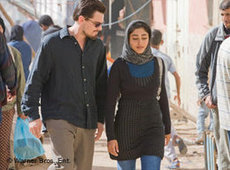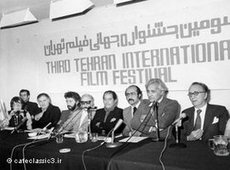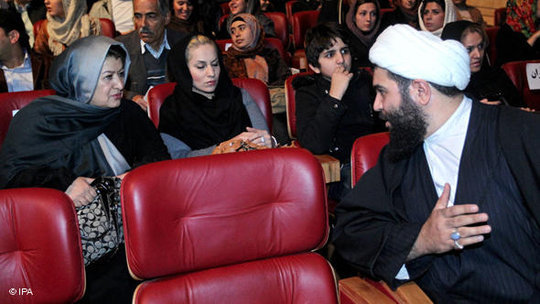Forbidden Love Scenes in the Pious Dinosaur Nation
Courts in Iran recently handed down prison sentences to two Iranian filmmakers, Jafar Panahi and Mohammad Rasoulof. The court of appeal found them guilty of acting against national security and creating anti-regime propaganda.
A few years ago, a young female actor who appeared alongside Leonardo DiCaprio in a Hollywood film was arrested and maltreated; she felt she had no choice but to leave the country.
Another even more recent case concerns another female actor. She was sentenced to a year in prison and 90 lashes for appearing in a film that had been approved by Iran's cultural authorities. Her colleagues protested against the decision in an open letter, saying that the Iranian film industry was simply not strong enough to bear a punishment such as this.
Contravention of Sharia law
In this film, the female actor in question plays the part of a young woman conducting an extramarital affair with a young man. They attend parties together outside the city. It goes without saying that no love scenes are shown in the film, and the party scenes are set in a dark location so full of cigarette smoke that it's difficult to make anything out clearly. But the main point is this: the woman appears before the camera without a headscarf, as her head is shaved totally bald. Sharia law dictates that the hair on the head must be covered up. A head with no hair, however, does not need to be covered up.
In an interview, the director of the film raises the question as to whether an actor can be held responsible for a crime committed in a film. Other colleagues of the actress point out that the world of film is fictional, not reality.

To a certain extent, everyone is pretending not to hear, see or know. In Iran, everyone has learned to conceal their disgust, yes even their anger. Everyone is afraid to reveal their innermost thoughts. Over time, everyone has learned to express themselves using the language of the leaders. Everyone asks each other with feigned, incredulous, innocent astonishment: "But why? What's the problem?" Nobody says it, but everyone knows the real reason.
But the hottest piece of news to emerge from this sector in recent times is that a government-appointed director, who produces television series about the lives of the saints, recently described the Iranian film industry as a "bordello". But even in an atmosphere such as this, even mediocre Iranian films do from time to time win important international prizes. So, as you can see, the situation is not totally hopeless.
The films of the Shah era
So what is happening in the Iranian film sector? Does it not reflect a much greater scandal involving all of Iran? There has been a flourishing Iranian film industry for more or less seven decades; around half the cinematic activity took place during the Shah era. The Iranian film industry is, in fact, the biggest film industry in Asia after India.
Before the revolution, going to the movies was the main leisure pastime for broad sections of the Iranian population. According to statistics, some of these films were so popular with audiences that they were seen by pretty much everyone in the towns and cities that had cinemas. This amounted to a fair number of towns and cities and, therefore, a fair number of inhabitants.
Typical protagonists in these films were a man, who was a rascal, and a woman, who worked as a dancer in a café, both living in a run-down part of the city. The dancer is wont to seduce our scoundrel, who devotes most of his time to roguish activities and consuming liquor in a café, thereby threatening his family life. But because the cinematic rascal was true to traditions which trace their origins back to religion, he eventually found his way back to his roots, desisted from his sins, broke off his relationship with the dancer and returned home to the bosom of his family.
The film usually ends at a pilgrimage site, the grave of a saint or a house of worship – a place where our scoundrel goes to light a candle, express regret for his misdeeds and recommit himself to the infinite mercy of the creator. Iranian audiences adored these films.

The Shah of Iran was generally opposed to the representation of political, social or economic problems in art, film and literature. During this era, a film was made about a resistance fighter who seeks refuge from persecution in the house of an old friend. Because someone informs the authorities about the hiding place, the fighter is killed when the house is blown up by a policeman.
In order to obtain official permission to screen the film publicly, the director was forced to turn the pursued guerrilla into a thief on the run, and of course the policeman was no longer required to blow up the house because the hounded partisan – now cast as a fleeing crook – gave himself up, full of regret. There were of course details in the film that made these changes obvious, for example the fact that the main protagonist was a thoughtful, strong character who bore no resemblance to a thief on the run.
During the same era, another film was screened. This film featured a simple farmer who discovers treasure in his village; with the help of the resulting wealth, he begins to commit foolish acts. This needed no explanation; everyone who saw the film knew that the ignorant farmer and the treasure that had fallen into his lap were an allegory of the Shah and Iranian oil. This film disappeared just five days after its movie premiere.
The Shah regime was well-disposed to the film about the rascal and the dancer and underestimated just how influential it could be in maintaining, propagating and promoting traditions. The regime was content with the film's fake modernism, and the Iranian public were content with their film.
The early years of the Islamic Republic
Of course, after the establishment of the Islamic Republic in Iran, production of these films brimming with sex, dancing, music and copious wine – which was of course the thing that made them so appealing – could no longer be continued, as it was all forbidden under Sharia law.
The women who had revealed parts of their bodies in these films found themselves under semi-house arrest or left the country. And suddenly, Iranian filmmakers and those involved in new efforts to establish theatres in Iran were confronted with a lack of female actors. A young director, a supporter of the Islamic Revolution, surprised everyone with his solution, which he announced with great alacrity: there was no necessity for the presence of women in film, one can make films that work perfectly well without actresses, he said.
This revolutionary director no longer lives in Iran, and of course he continues to produce his astonishing works. All the members of his family are filmmakers, receive international prizes for their work and dedicate them with consummate magnanimity to Iran's detained artists and political prisoners.

The disappearance of the Shah-era film industry suddenly created a large vacuum. And until the regime began to rebuild the sector in a manner that it found acceptable – something it has not quite managed yet – a space for enlightened Iranian cinematic art emerged. Suddenly Tarkovsky was very fashionable. But the new regime did not subscribe to these progressive impulses and immediately silenced any Tarkovsky-style characteristics.
Then some filmmakers made films using ideas based on eastern teachings, which found absolutely no audience at all. Naturally, this genre did not last very long. Propagandist productions, commissioned by the government and described as "valuable films", also formed part of this rather unappealing body of cinematic work.
It wasn't long before foreign videos and old Iranian films moved in to fill the vacuum. These films could not be sold officially, which led to the development of an extensive black market in American, Iranian, Indian and Japanese films, which in turn created a new arena for the game of cat-and-mouse between the residents of Tehran and other large cities, and the government.
Practically all those who wanted to see these films saw them; just as those who wanted to consume alcoholic beverages did so. There's a black market for all forbidden things in Iran, because there are always people who have the necessary connections and people who are unable to resist the temptation of a large, lucrative market.
Given these circumstances, several politicians working in the field of arts and culture came to the conclusion that by giving Iranian filmmakers more creative space, they could lessen the devastation inflicted by consumers' access to illegal goods and films that contradict Sharia law. Obviously, this film production process would remain under the control of cultural authorities, but it was decided that the industry should be stimulated through competition.
As a result, general regulations were amended and producers were no longer obliged to make films that only served to disseminate propaganda and were therefore unpopular with audiences. But what kind of films would these be – without sex and politics?
Iranian film today: colourful and modern
For a while, Iranian filmmakers focused on the issues of divorce and addiction, but it was clear that this couldn't go on indefinitely. Cue beautiful women – naturally under the cover of an Islamic veil – and good-looking young men. A modern, colourful life became the subject of films, which feature people playing tennis, skiing and weekending in seaside villas.
The protagonists wear expensive designer sunglasses, clothes and wristwatches. Sometimes, to enhance the appeal of a film, the location will be moved to Turkey, Bulgaria or Ukraine, with everyone behaving as though they are in Western Europe. And suddenly, Iranian audiences and young people in particular found films that were to their taste.

The influence of the West
The Shah paid no attention to the influence of cinema at the time, but today's rulers are only too well aware of its effect. It is the issues set down by the West, whether these be good or bad, that define contemporary life. The contrast to this represented by the country's rulers is evident on all levels. While you can find millions of Iranians who speak fluent and correct English, it's not been possible to find a single person among all those who govern Iran who would be able to speak in this language on an international stage without obvious mistakes; compare that to Iran's neighbours.
A photograph was recently published on the Internet showing the rooftops of a small number of Tehran houses. The picture has been taken from the air and shows that in this district at least, all rooftops are crowned with satellite dishes. In addition, since the advent of the Internet and the easy, rapid access that Iranians now have to all kinds of foreign films, the issue of how young Iranians may be corrupted by watching Iranian films whose directors have been arrested has lost its significance.
A much greater problem is that the Iranian film has to recognise its limitations, or, to use an Iranian saying, measure its step to match the length of its kelim. But in the end, it is the government that determines the length of the kelim.
Amir Hassan Cheheltan
© Frankfurter Allgemeine Zeitung/Qantara.de 2011
Amir Hassan Cheheltan's most recent novel is titled Amerikaner töten in Teheran (Killing Americans in Tehran).
Translated from the German by Nina Coon
Editor: Aingeal Flanagan/Qantara.de
